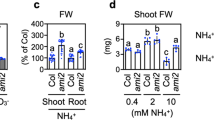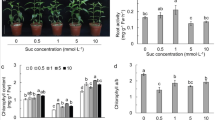Abstract
THE toxic responses of plants to ammonia supplied as anhydrous or aqueous ammonia or ammonium salts are well documented1–3; but relatively little is known regarding the means by which toxicity to either plant or animal cells is brought about4. In the course of an investigation of this problem it was found that ammonia strongly inhibits the exogenous utilization of glucose, pyruvate, citrate, α-ketoglutarate, succinate and malate by a number of intact tissues and particulate preparations from plant sources. Of the Krebs' cycle substrates, succinate was inhibited less by ammonia than the others used. This partial resistance of succinate oxidation to ammonia inhibition pointed toward a possible effect on diphosphopyridine nucleotide since this does not serve as a co-factor for succinate oxidation. To investigate this question further, studies were made of the effect of ammonia on the reduction and oxidation of diphosphopyridine nucleotide in homogenates of red beet-root, using the 340 mµ absorption peak of the reduced diphosphopyridine nucleotide. Homogenates of the fresh root of red beet (Beta vulgaris) were prepared in the cold by hand grinding and centrifugation. The suspending medium was 0.2 M tris (hydroxymethyl) aminomethane buffer at pH 8.5 containing 1.0 M sucrose and 5 × 10−3 M ethylenediamine tetra acetic acid.
This is a preview of subscription content, access via your institution
Access options
Subscribe to this journal
Receive 51 print issues and online access
$199.00 per year
only $3.90 per issue
Buy this article
- Purchase on Springer Link
- Instant access to full article PDF
Prices may be subject to local taxes which are calculated during checkout
Similar content being viewed by others
References
Grogan, R. G., and Fink, F. W., Phytopath., 46, 516 (1956).
Lorenz, O. A., Bishop, J. C., and Wright, D. N., Proc. Amer. Soc. Hort. Sci, 65, 296 (1955).
Nightingale, C. S., Bot. Rev., 15, 185 (1948).
Baldwin, E., “Dynamic Aspects of Biochemistry”, third ed. (Cambridge University Press, 1957).
Beevers, H., Plant Physiol., 29, 265 (1954).
Author information
Authors and Affiliations
Rights and permissions
About this article
Cite this article
WEDDING, R., VINES, H. Inhibition of Reduced Diphosphopyridine Nucleotide Oxidation by Ammonia. Nature 184, 1226–1227 (1959). https://doi.org/10.1038/1841226a0
Issue Date:
DOI: https://doi.org/10.1038/1841226a0
Comments
By submitting a comment you agree to abide by our Terms and Community Guidelines. If you find something abusive or that does not comply with our terms or guidelines please flag it as inappropriate.



